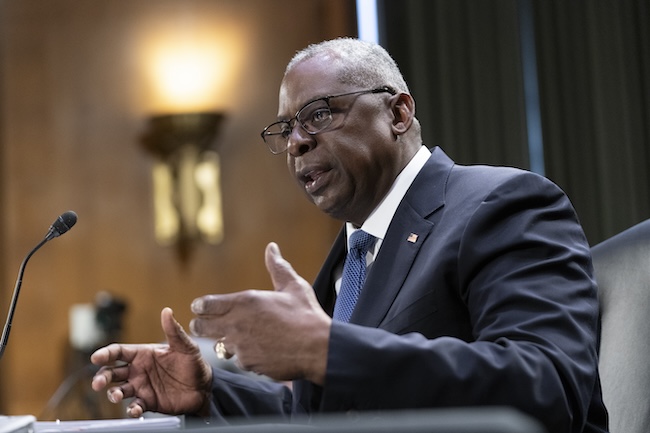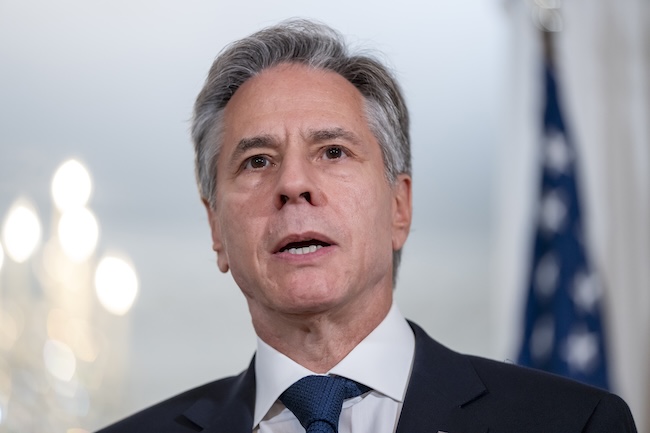
Defense Secretary Lloyd Austin testifies before a Senate Appropriations Committee hearing on Capitol Hill in Washington on Oct. 31, 2023 in this photo released by the Associated Press. (Image courtesy of Yonhap)
WASHINGTON, Nov. 2 (Korea Bizwire) — Escalating tensions in the Middle East and Russia’s protracted war in Ukraine are raising anew consequential security questions over whether the United States can respond to a third crisis concurrently should it arise on the Korean Peninsula, the Taiwan Strait or elsewhere.
After the war between Israel and Hamas erupted following the militant group’s surprise attack last month, U.S. Secretary of Defense Lloyd Austin and other officials highlighted the U.S.’ capability to deal with crises in “multiple theaters,” but doubts still linger.
Experts said that Washington may step up efforts to leverage its multi-layered network of regional alliances and partnerships to address the ongoing wars and other global challenges while trying to prevent the existing wars from widening and a new conflict from emerging.
“The United States has the ability to manage multiple crises, but not fight and win multiple wars,” Patrick M. Cronin, Asia-Pacific security chair at the Hudson Institute, told Yonhap News Agency via email.
“The Biden administration will have to muster all policy tools, call on all allies and partners, and even then make hard trade-offs over the level of support and the scope of the U.S. role should violence spread in Europe or the Middle East or break out in Asia,” he added.
Concerns have persisted over whether the U.S. can respond swiftly and adequately to foreign crises and global conflict amid lingering domestic sentiment against America’s entanglements in overseas affairs and intense polarization at Capitol Hill.
Brushing aside those concerns, Austin stressed that the U.S. can “walk and chew gum at the same time.”
“Make no mistake. The U.S. will remain able to project power and to direct resources to tackle crises in multiple theaters,” Austin told a press briefing just days after the Oct. 7 Hamas attack.
Questions, however, remain over whether the U.S. can continue to focus even on sufficiently supporting Ukraine and Israel amid delays in the congressional passage of the Biden administration’s funding request for them, as well as concerns over the potential depletion of the U.S.’ own weapons stocks.
“Neither Ukraine nor Israel is a major regional conflict for the United States. So far, U.S. forces are not committed to battle in either theater,” Bruce Bennett, a defense analyst at RAND Corp., said, characterizing the conflicts as “lesser regional contingencies.”
“Even then the U.S. is depleting its military equipment and munitions stocks. For example, Ukraine reportedly fires 6,000 to 8,000 artillery shells and rockets per day, and the U.S. still isn’t producing as many as 1,000 shells and rockets per day,” he added.
South Koreans have shared concerns about the U.S.’ capability to handle simultaneous conflicts in multiple regions, as North Korea has been doubling down on its menacing nuclear and missile programs with dim prospects for the resumption of diplomacy with the recalcitrant regime.
Apparently mindful of concerns in Seoul, Washington took a series of steps last month to highlight its “extended deterrence” commitment to using the full range of its military capabilities, including nuclear, to defend South Korea.
A few of these steps included the first known landing on South Korean soil last month of a B-52H strategic bomber, the port visit of the nuclear-powered USS Ronald Reagan (CVN 76) aircraft carrier to Busan Naval Base and the joint South Korea-U.S. observation of a Minuteman III intercontinental ballistic missile test at Vandenberg Air Force Base in California.

Secretary of State Antony Blinken speaks at the State Department in Washington on Oct. 30, 2023, in this photo released by the Associated Press. (Image courtesy of Yonhap)
In addition to that, Austin and Secretary of State Antony Blinken plan to visit Seoul later this month on separate trips designed to underscore America’s “ironclad” security commitment to South Korea, according to their offices.
Their Asia trips are also expected to highlight that despite the Israel-Hamas war and Russia’s war in Ukraine, the U.S. would continue to put its strategic policy priority on the Indo-Pacific, which the Biden administration has cast as the “epicenter” of geopolitics in the 21st century.
“We remain laser-focused on the Indo-Pacific. Peace and security across the Indo-Pacific region will remain central, will remain vital to America’s own peace and prosperity and security in the coming century,” Assistant Secretary of State for East Asian and Pacific Affairs Daniel Kritenbrink told reporters in a telephonic conference.
“We’ve demonstrated that through the range of steps we’ve taken over the last three years, not to mention the last several decades. And certainly, I think the fact that the secretary is again traveling to the region, even amidst these global challenges, just further reinforces that point,” he added.
As doubts over the U.S.’ security commitment to Asia reemerged, the Pentagon announced last Friday that it will pursue a modern variant of the B61 nuclear gravity bomb, a centerpiece of America’s nuclear stockpile, to respond to a “rapidly evolving” security environment.
The move to produce the variant, designated as the B61-13, appeared to underscore that America has various options in its military toolbox to tackle multiple security challenges from potential adversaries.
Along with the show of nuclear deterrence, Washington has been stepping up its diplomacy toward Beijing under the mantra of “de-risking” — not decoupling — the relationship between the U.S. and China.
“Which party in the ongoing conflicts China will throw its weight behind would be a crucial factor that can affect the overall trajectory of the conflicts,” Kim Heung-kyu, the head of the U.S.-China Policy Institute at Ajou University, said. “It would thus be important for the U.S. to ensure that the relationship with China will not go in an antagonistic way.”
As global challenges intensify, the Biden administration is expected to capitalize on the growing network of alliances and partnerships, including trilateral cooperation among the U.S., South Korea and China and the AUKUS grouping involving the U.S., Britain and Australia as well as the Quad forum consisting of the U.S., Australia, India and Japan.
In Antony Blinken’s September speech at Johns Hopkins School of Advanced International Studies, the U.S. Secretary of State made it clear that the U.S. will leverage the network of alliances and partnerships in fit-for-purpose groupings, highlighting his concept of “diplomatic variable geometry.”
“We start with the problem that we need to solve and we work back from there — assembling the group of partners that’s the right size and the right shape to address it. We’re intentional about determining the combination that’s truly fit for purpose,” he said.
In the military domain, the Pentagon is expected to push for an “integrated” deterrence framework involving coordinated contributions from U.S. allies, including South Korea and Japan.
(Yonhap)






